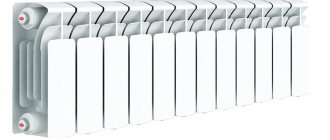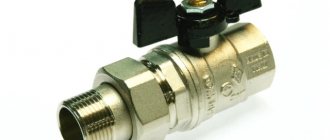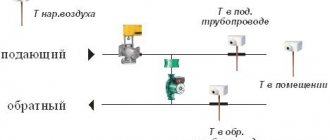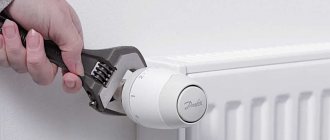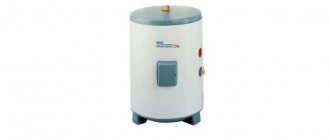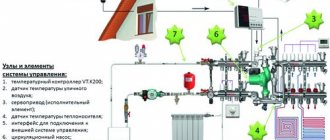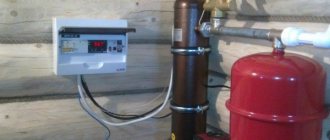The ability to regulate the temperature of heating radiators allows you to create a pleasant microclimate in the room and significantly save on utility bills in winter.
heating adjustment
The cost of coolants increases from year to year, so you need to know how to regulate the temperature of a heating battery in order to do it yourself, without involving expensive specialists. The uniformity of heating of all rooms in the home depends on the quality of this work.
How to regulate radiators
To understand how temperature regulation occurs, let’s remember how a heating radiator works. It is a labyrinth of pipes with different types of fins to increase heat transfer. Hot water enters the radiator inlet, passing through the labyrinth, it heats the metal. This, in turn, heats the air around it. Due to the fact that modern radiators have specially shaped fins that improve air movement (convection), hot air spreads very quickly. During active heating, there is a noticeable flow of heat from the radiators.
This battery is very hot. In this case, the regulator needs to be installed
From all this it follows that by changing the amount of coolant passing through the battery, you can change the temperature in the room (within certain limits). This is what the corresponding fittings do - control valves and thermostats.
Let's say right away that no regulators can increase heat transfer. They only lower it. If the room is hot, install it; if it’s cold, this is not your option.
How effectively the temperature of the batteries changes depends, firstly, on how the system is designed, whether there is a reserve power of the heating devices, and secondly, on how correctly the regulators themselves are selected and installed. The inertia of the system as a whole, and the heating devices themselves, plays a significant role. For example, aluminum heats up and cools down quickly, while cast iron, which has a large mass, changes temperature very slowly. So there is no point in changing anything with cast iron: it takes too long to wait for the result.
Options for connecting and installing control valves. But to be able to repair the radiator without stopping the system, you need to install a ball valve before the regulator (click on the picture to enlarge its size)
Tools and improvised means
If you want to balance a two-pipe heating system, it is important to know what tools and instruments may be needed for this. In fact, the action is carried out using a minimal set of devices. Among them:
- 1. Electronic contact thermometer.
- 2. Screwdriver.
- 3. A thumb or key that allows the rod to rotate. In most cases, craftsmen use a regular hexagon for this task.
- 4. A sheet of paper and a pencil.
In the professional field, a thermal imager is also used for balancing work. It allows you to accurately determine where the level of heating is too high, and where it is significantly underestimated. The device is not cheap, so it is better to make do with improvised means.
In addition to the non-contact thermometer, a remote pyrometer is used for adjustment. It is known to be able to measure the temperature of shiny surfaces with minimal deviations.
If there is no wiring diagram for the heating system in the room, you will have to draw it up yourself on a sheet of paper. A correctly drawn up sketch will allow you to quickly understand the order in which heating units are connected to the mains, as well as determine their distance from the furnace room. At the stage of self-setup of the equipment, it is necessary to carry out a comprehensive flushing of the mud trap at the entrance to the boiler, and also warm up the system to 70-80 degrees Celsius.
Do-it-yourself water heating in a private house and its installation
Balancing the system using valve regulators
It is possible that the very design of the system requires balancing. For example, one long arm is used and the other is short.
Or the arm length of the dead-end pattern is too long. Or a beam scheme is used, which requires initial configuration. And it happens that they make archaic one-pipe systems with shortcomings. In either case, the result is significant uneven heating.
So, balancing valves are installed on the radiators; all that remains is to ensure that the temperature of all radiators is approximately the same.
The principle of balancing is the simplest - do not close (open as much as possible) the taps on the coldest ones and “tighten” the hottest ones a little. As a result, more coolant will flow to the cold ones, less to the hot ones, and their temperature will equalize.
Automatic adjustment
Automatic maintenance of room temperature is good because once you set the control knob to the desired position, you will get rid of the need to twist and change something for a long time. The temperature of the heating radiators is adjusted constantly and continuously. The disadvantage of such systems is their significant cost, and the more functionality, the more expensive the device will be. There are some other features and subtleties, but more on them below.
Adjusting radiators with thermostats
To maintain a constant set temperature in a room (room), thermostats or thermostats for heating radiators are used. Sometimes this device may be called a “thermostatic valve”, “thermostatic valve”, etc. There are many names, but one device is meant. To make it clearer, it is necessary to explain that the thermal valve and thermal valve are the lower part of the device, and the thermal head and thermoelement are the upper part. And the entire device is a radiator thermostat or thermostat.
This is what the thermostat on the radiator looks like
Most of these devices do not require any power source. The exception is models with a digital screen: batteries are inserted into the thermostatic head. But their replacement period is quite long, the current consumption is low.
Structurally, the radiator thermostat consists of two parts:
- thermostatic valve (sometimes called “housing”, “thermal valve”, “thermal valve”);
- thermostatic head (also called “thermostatic element”, “thermoelement”, “thermal head”).
The valve itself (body) is made of metal, usually brass or bronze. Its design is similar to that of a manual valve. Most companies make the lower part of the radiator thermostat unified. That is, heads of any type and any manufacturer can be installed on one body. Let us clarify: you can install a manual, mechanical, or automatic thermocouple on one thermal valve. It is very comfortable. If you want to change the adjustment method, you do not need to buy the entire device. They installed another thermostatic element and that was it.
The difference between a manual radiator regulator and an automatic one is only in the installed thermal head
In automatic regulators, the principle of influencing the shut-off valve is different. In a manual regulator, its position is changed by turning the handle; in automatic models there is usually a bellows that presses on the spring-loaded mechanism. In electronic devices, everything is controlled by the processor.
The bellows is the main part of the thermal head (thermoelement). It is a small sealed cylinder containing liquid or gas. Both liquid and gas have one thing in common: their volume is highly dependent on temperature. When heated, they significantly increase their volume, stretching the bellows cylinder. It puts pressure on the spring, blocking the flow of coolant more strongly. As it cools, the volume of gas/liquid decreases, the spring rises, the coolant flow increases, and heating occurs again. This mechanism, depending on the calibration, allows you to maintain the set temperature with an accuracy of 1oC.
Watch the video to see how the thermostat works.
The radiator thermostat can be:
- with manual temperature control;
- with automatic; with built-in temperature sensor;
- with remote (wired).
Using Three-Way Valves
A three-way valve is rarely used to regulate battery temperature. He has a slightly different task. But in principle, it is possible.
By installing a three-way valve on the supply side, you can also regulate the coolant temperature
A three-way valve is installed at the junction of the bypass and the supply pipe going to the radiator. To stabilize the temperature of the coolant, it must be equipped with a thermostatic head (of the type described above). If the temperature near the head of the three-way valve rises above the set value, the flow of coolant to the radiator is blocked. It all rushes through the bypass. After cooling, the valve operates in the opposite direction and the radiator heats up again. This connection method is implemented for single-pipe systems, more often with vertical wiring.
What to do with a stuck ball valve
If ball valves are not rotated for years, they tend to sour and jam. In such a situation, do not try to resolve the issue physically and do not force the “butterfly” with pliers or a gas wrench. It is made of a brittle alloy and will probably break. Proceed like this:
- Unscrew the locking nut and remove the butterfly handle from the stem.
- On most of these valves, you will find a nut under the handle that clamps the plastic seal. Loosen it by turning the wrench half a turn. If there is no nut, go to the next step.
- Take an adjustable wrench or other device that allows you to securely grab the flats on the rod. Without applying much force, turn it as far as possible.
- When you feel resistance, turn the rod back all the way and forward again, trying to turn it a few more degrees. Work carefully and without haste!
- In this way, rotate the valve 90°, then tighten the gland nut and reinstall the handle.
An adjustable wrench can be used to firmly grasp the edges
Advice. If you have WD-40 spray lubricant in your household, apply it to the stem and wait 5-10 minutes before rotating.
Be doubly careful when turning off radiators with soured taps during the heating season. If you hurry too much and apply too much force, you will break off the metal rod or ball, and in the worst case, the valve body will burst. A stream of hot water can shoot out from the crack, which can burn you. While you go down to the basement and close the heating riser, the coolant will cause damage to the interior of the room, and you can roughly guess how much it costs to renovate the apartment now.
If you are not sure of your actions, call a plumber. More information on how to close a jammed ball valve in order to disconnect the radiators is described in the video:
How to regulate a heating battery?
How to adjust the battery? General recommendations
Perhaps you don’t know how to adjust the radiator in your apartment. Then the tips below will help you. To do this correctly, just closing/opening the control valve on the radiator is not enough. Depending on the number of radiators connected to the system, you need to open a certain number of them by a certain number of revolutions. For example, there are four batteries installed that are connected to the central heating system. To distribute the pressure over it, the first battery opens several turns, the next - three, another - four, and so on. Now you know how to adjust the radiator manually. And, as it becomes clear, this is easy to do, and your rooms in the apartment will heat up very quickly to the temperature you need.
The answer to the question of how to regulate batteries takes on a different meaning if there is an option for forced pumping of liquid. Then you have the opportunity to install three-way valves on all batteries. Then it will not be difficult to regulate the temperature in the radiators. So, in order to significantly simplify the setup, each battery should be equipped with special valves that allow you to control the flow of heat and the rational consumption of heating equipment. If the room is hot or it is closed and not in use, the valve allows you to reduce or close the flow of hot water into the battery.
How to regulate batteries using a valve
In multi-apartment buildings, valves are most often installed at the exit/input from the elevator unit of the heating system. These devices in their own housing have 2 rings made of steel, protected from corrosion. They encircle the coolant passage. Several more of these rings are located on the surface of the valve, in particular in its moving part, which is very convenient.
Next you will read how to regulate the temperature of a radiator. If the valve is located at the bottom and lowers, then it impedes the movement of liquid, and if it is moved upward, it goes beyond the circulating flow. To close it, the user must rotate the handwheel, which drives a screw-threaded rod. For hot liquids and heating systems, it is best to use a graphite valve. There is no alternative to it if the pipe diameter is over 50mm.
Control valves
Operating principle
A control valve for a heating radiator is a device that allows you to automatically control the movement of the coolant.
The design of such products is quite complex, but they also work much more efficiently than valves for manual adjustment:
The bellows, a container filled with liquid or gas, is responsible for sensing the outside temperature. As the temperature rises, the bellows expands, affecting the control unit.
Note! The price of liquid and gas-filled devices is approximately the same, but the operating features are different. Thus, gas models react faster to temperature changes, while liquid models more accurately convey the impact on the coolant flow
- The expanded bellows presses on the valve stem, which lowers and gradually closes the valve saddle, through which hot water enters the battery.
- When cooling, the opposite situation is observed: the rod rises and the lumen of the saddle expands.
We set the degree of initial compression of the bellows ourselves, either by setting the temperature value we need on the digital display, or by rotating the mechanical adjustment knob. It is also possible to connect the thermal valve with external sensors - in this case, the movement of the rod is controlled not by a bellows, but by a servo drive under the influence of an electrical or hydraulic system.
Installation of thermostatic tap
Among specialists, the question of whether it is necessary to install taps on heating radiators is practically not discussed. Even installing a simple ball valve provides a number of advantages, and the presence of a high-quality thermostat is even more so. However, the instructions advise following a number of rules when installing such devices:
Example of correct installation of the product
- First, you need to select a suitable valve modification. For systems with one pipe we use products of type RTD-G, for two-pipe systems - RTD-N.
- Secondly, before installing taps on heating radiators, we check the direction of movement of the coolant (indicated by an arrow on the body). If we mix it up, the device will work any way, just not the way we need it.
- Thirdly, we place the thermoregulation head perpendicular to the plane of the battery. so that the heat flow does not affect its operation.
How to regulate heating radiators using taps is also a fairly simple question:
- Having installed the valve on the radiator, we check the tightness and supply coolant to the system.
- Using the handle or dial, set the average temperature.
- After about an hour, we adjust the valve setting according to our feelings and checking the thermometer in the room.
- If necessary, repeat the adjustment again. however, this is usually not required.
The system is adjusted by rotating the handle
After this, it is usually necessary to interfere with the operation of the device no more than once a month - in case of sudden changes in external temperature.
What else you should know
If you are wondering how to turn off the battery if there is no tap, then there is a solution here too. True, the option of blocking the riser is inevitable here. In this case, not only the individual battery will be blocked, but also part of the heating system. In small cities, the practice of turning off the heating independently is often used, just by shutting off the riser. It is turned off using a valve in the basement. At that point he approaches the sun lounger. Water valves are usually within sight.
You can find out which fittings are suitable for shutting off the heating in the technical documentation. Additionally, this should be known to an experienced plumber who is familiar with local utilities. In most cases, the heating system is shut off using a brass valve or a valve.
In the event that the window sill blocks the battery, there is no single solution. It all depends on the degree of overlap. So, for example, if the window sill completely blocked the battery, then this is considered unacceptable. This is explained by the concept of convection, in which warm air rises. There it replaces cold air, which goes down, after which it is heated by the battery. Thus, the room is heated. If the window sill completely blocks the radiator, then the convection process is hampered and the room does not warm up well. But there will definitely be a way out of this situation. You can make several rectangular holes in the window sill and cover them with decorative grilles.
- So, shutting off the batteries in an apartment is possible and, in some cases, even necessary. This can be most conveniently accomplished with special taps.
- After the end of the heating season, it is recommended to close one of them and leave the second open.
- On the day of heating, we close both taps for 1-2 days so that rusty water flows and eliminates the possibility of blockages.
- If there is no tap, then you will have to shut off the riser using a special valve or valve, which are most often located in the basement of the building, and usually in a visible place.
The main thing is to do everything thoughtfully and strictly in accordance with all standards and requirements. Do not close both taps at the end of the heating season, this may cause deformation and cracks in them. Do not forget about the basic rules that will help you shut off the battery in your apartment safely and correctly.
Criterias of choice
A radiator valve is, as a rule, a ball-type device that regulates water flow and connects pipes to the radiator.
Installed on the bypass, risers, at the top of the battery, in places where air accumulates to bleed it. Choosing a suitable faucet is not difficult, just know a few nuances:
- the diameter of the pipes to which it will be connected (DN, in millimeters or inches);
- working pressure (PN, in the range of 15–40 and above);
- type of connection, presence of thread inside or outside, American.
The choice should take into account the purpose of the reinforcement, its location, and the properties of the environment
The ratio of the input and output of the valve in the radiator, their relative position is also important
When choosing, you should consider the characteristics of the cranes:
- Ball valves, although the most common and affordable, are not very effective. It has only two modes: closing/opening;
- a cone valve is a more acceptable option due to the possibility of an intermediate position. Disadvantage: the tap must be returned to its original position and constantly monitored;
- An automatic thermostat is the most efficient, reliable, but also much more expensive than others. When installing it on a one-pipe system, a bypass must be present.
Why do you need to make adjustments?
Setting the optimal temperature of the heating radiators allows you to create the most comfortable living conditions indoors. In addition, adjustment allows:
- Remove the effect of air in the batteries, allow the coolant to move freely through the pipeline of the heating system, effectively transferring its heat to the interior of the room.
- Reduce heat consumption costs by up to 25%.
- Do not keep windows constantly open if the air in the room is excessively overheated.
It is advisable to set up heating and adjust batteries before the start of the heating season. This is necessary so that later you do not experience discomfort in the apartment and do not adjust the heating temperature of the batteries in emergency mode. Before setting up and adjusting the radiators, initially in the summer you need to thermally insulate all windows. In addition, you need to take into account the specific location of the apartment:
- In the middle or corner of the house.
- Lower or upper floor.
After analyzing the situation, it is advisable to use energy-saving technologies to maximize heat conservation inside the apartment:
- Insulate walls, corners, floors.
- Carry out hydro and thermal insulation of the seams between the concrete joints of the panel house.
Without this work, it will be useless to regulate the temperature of the radiators, since the lion's share of the heat will heat the street.
Disadvantages of a one-pipe system
The disadvantages include the fact that with such a system it is impossible to take into account the heat consumption in each apartment. And, therefore, make an individual calculation of payment for the actual consumption of thermal energy. In addition, with such a system it is difficult to maintain the same air temperature in all living areas of the building.
That is why other apartment heating systems are used, which are designed differently and require the installation of heat energy meters in each apartment.
Currently, there are various apartment heating systems. However, so far they are installed in multi-storey buildings extremely rarely. This is due to a number of reasons. In particular, due to the fact that such systems have low hydraulic and thermal stability.
Most often, in multi-storey residential buildings, so-called central heating is used.
In recent years, autonomous heating has been used in the construction of new residential buildings. With this method of individual heating, the boiler room is installed directly in the basement or attic of a high-rise building. In turn, heating systems are divided into open and closed. The first provide for the division of hot water supply for residents for heating and other needs, and in the other - only for heating.
Adjusting heating flow or return
In some cases, hydraulic balancing—adjustment of flow and return—will help to effectively redistribute heat throughout the heating system. In this case, the coolant is directed from places of its excess to areas experiencing a deficiency.
In apartment buildings, the procedure is carried out in accordance with the state energy saving program. In a private cottage, this is the task of the owner himself. In addition to equalizing the temperature on all branches of the system, hydraulic balancing helps reduce energy consumption and, consequently, heating costs.
The work is performed by qualified specialists. In pipes with a length of 10 meters or more, and in areas remote from the circulation pump, balancing valves are installed. It is possible to divide the system into autonomous modules with individual settings, which is appropriate for obtaining different heat transfer in each room.
Preparation for the procedure
Before you start balancing, prepare everything you need for it. To get started, you will need the following:
- A special contact thermometer with which you can accurately determine the degree of heating at various points.
- In order to adjust the balancing valve, you will need a hex wrench.
- If it has been preserved, it is advisable to take a heating wiring diagram. It may not exist if the equipment was installed a long time ago or was done without a diagram prepared in advance.
- You will need paper, pencil and marker.
Instead of a contact thermometer, you can use other models. Professional specialists often use a specialized thermal imager for this purpose. You can also use a remote pyrometer.
If there is no wiring diagram, then you need to sketch out a plan for the location of its elements yourself. First of all, the sequence of connecting the radiators and their distance from the boiler room are noted. Balancing a two-pipe heating system is similar to what is done for a single-pipe one.
When heating balancing begins, the mud trap at the inlet of the heating boiler is cleaned. Then it is necessary to warm up the heating boiler. This must be done up to maximum operating temperature. It doesn’t matter whether the weather outside is cool or hot.
How to heat a private house Source septik-pro.com
If the batteries are too hot
In this case, the question arises of how to adjust the heating radiators in the apartment. The user cannot change the network temperature; all that remains is to reduce the fluid flow rate in the heating devices. For this purpose, special manual or automatic devices are used.
A manually operated valve is the simplest and long-known method. By reducing the available cross-section of the pipe using a rod, we reduce the flow of heated liquid into the radiator and thereby reduce its heat transfer. In this case, you should check whether such “heat adjustment” will not be an unprofitable enterprise: when all batteries are connected in parallel, a decrease in the flow in the first one automatically causes cooling of the others. Thus, if the first radiator in the chain is located in the bedroom and it is too hot, you can reduce its heating. But then the last radiator - for example, in the kitchen - will turn out to be almost cold and the heating in the room will be insufficient.
Important: if it is hot in the apartment, but the heating system is single-pipe, adjustment can only be made if there are bypasses (jumpers). Otherwise, by “screwing on” the batteries at home, you can get into trouble with neighbors living “further down the riser” or with utility employees
With a two-pipe scheme, such problems do not arise.
To regulate heating radiators, install either a valve and a ball valve on the inlet and outlet pipes, respectively, or a thermostat on the heating radiator.
Important: a valve must be installed on the supply pipe, not a ball valve! The valve is a purely shut-off valve with two operating positions - “open” and “closed”. Intermediate positions of the ball lead to its gradual destruction by solid particles of the coolant, therefore the “lifetime” of such a valve is much shorter than that of a valve
The valve is considered a shut-off control valve for heating and has a wider range of operating positions between the extremes.
To manually adjust the heating system in an apartment, special control valves with direct or angular connections are used.
The choice of the desired position of the rod in this case depends on the outside temperature, the heating of the water supplied to the heating system and the wishes of the users. How to regulate radiators with a regulator? Carefully monitor the temperature in the apartment (house) and “tighten” the valve to the desired result. Interestingly, manual valves have a built-in thermal valve and you can relatively easily turn a device for manual adjustment into an automatic one by purchasing and attaching a thermal head to it.
Automatic regulators
Automatic devices consist of a thermal valve and a thermal head.
The valve allows you to change the cross-section in the supply pipe; the thermal head, based on remote or built-in temperature sensors, as well as additional controllers, gives a command to change the position of the rod in the valve.
The simplest (and cheapest) version of the device contains a capsule of gas or liquid, which expands and contracts under the influence of temperature changes. The rod piston located next to this capsule moves towards decreasing or increasing the flow area of the pipe. More complex devices are powered by a battery or accumulator and transmit force to the rod using electric current. Some options connect to the home electrical network, for example, thermostats built into the overall smart home system.
The question of how to regulate the temperature of a heating battery using a thermostat - in a fully automated mode or with the control of the homeowner - is decided depending on the general scheme of the smart home system and the features of its operation.
An important nuance: for normal operation of a device with a remote temperature sensor, it is necessary to ensure constant and free air circulation near the thermometer. If the sensor is located directly in the thermal head, it is better to mount it horizontally (perpendicular to the main plane of the radiator), since it is in this position that the heating elements have the least effect on the thermometer.
The quality of operation of remote temperature sensors is also affected by:
- thick curtains covering it;
- the distance between the window sill and the sensor is too small;
- installation of a heating device in a niche.
Manual valves
Manually adjustable valves allow you to change the volume of coolant entering the radiator by increasing or decreasing the diameter of the passage hole.
The valve includes a valve with a shut-off head. It, in turn, is connected to a handle, on which a scale with divisions can be applied. Turning the handle causes the shut-off head to move and the volume of incoming coolant to change to a smaller or larger direction. The marks on the scale allow you to set the required battery temperature.
Manual valves are simple, reliable and inexpensive, but require regular monitoring.
How to adjust (reconfigure)
All thermostats are factory adjusted. But their settings are standard and may not match your desired parameters. If you are not satisfied with something in the work - you want it to be warmer/colder, you can reconfigure the thermostat for the heating radiator. This must be done with the heating running. You will need a thermometer. You hang it at the point where you will control the state of the atmosphere.
- Close the doors, put the thermostat head in the extreme left position - completely open. The room temperature will begin to rise. When it becomes 5-6 degrees higher than what you want, turn the regulator all the way to the right.
- The radiator begins to cool down. When the temperature drops to a value that you consider comfortable, begin to slowly turn the knob to the right and listen. When you hear the coolant making noise and the radiator starting to warm up, stop. Remember what number is on the handle. It will need to be set to achieve the required temperature.
Adjusting the thermostat for a radiator is not difficult at all. And you can repeat this action several times, changing the settings.
How to properly connect a bimetallic radiator?
Very often, and in the fall almost every day, on the most popular forum in RuNet on the topic of installation, mastergrad.com, topics or messages appear asking about problems connecting bimetallic radiators in apartments, and I am very sorry that in our time, when there is access to any information in networks, many people are faced with this problem when turning to “specialists” to replace radiators who do not have the slightest idea how this installation is performed. And the question is not only that the radiators do not warm up completely or completely, which casts doubt on the feasibility of such a replacement, but also that installation is also often carried out with serious violations of the design conditions of the heating system, which seriously affect its reliability, thereby The life and health of residents is in serious danger. In this topic, by posting photos of my work, I will try to give simple advice on how to connect radiators so that all building codes are observed and new heating devices are fully heated.
Which pipes should I choose for installing radiators?
Firstly, I would like to immediately decide on the type of pipeline material with which the new radiator is connected: if in the house according to the project the risers of the heating system are made of black steel pipe, then the inlets to the radiator should also be made of steel. Options made of plastic pipes (polypropylene, metal-plastic) are significantly inferior in reliability to steel pipes and are categorically unacceptable in systems designed from steel, especially with open installation, which is unacceptable according to SNiP requirements; connecting a radiator with copper pipes and stainless steel pipes, I personally consider inappropriate for economic and aesthetic reasons, as well as due to decreased reliability of the pipe due to the significantly smaller wall thickness.
Secondly, it’s worth determining the type of connection for the pipeline; it’s hard to argue that gas welding is optimal, both for reasons of reliability (with threaded connections there is always a weak point - a snag) and from an aesthetic point of view due to the absence of threaded fittings
It is also important that risers installed by house builders rarely have the correct geometry relative to the walls and floor, but with gas welding, installers can easily correct all the unevenness left by the builders
Heat Shield Materials
Foil foam is usually found in retail sales as short rolls. The thickness of the material layer in this case is up to 3 millimeters, and for foamed polyethylene – up to 4 millimeters. The thermal insulation properties of these materials are comparable to the properties of a 100 mm layer of mineral wool insulation.
When placing a screen that reflects heat, one can and should take into account such an important factor as the minimum distance between the edge of the radiator section of the battery and the inner wall, which is 4 mm. If you change this distance downward, it will complicate or disrupt the circulation of warm air and, as a result, convective heat transfer and the efficiency of the radiator.
Special cases of placing a heating battery on the wall do not allow the installation of a full-fledged screen that reflects heat. The way out of this situation is to mount aluminum foil on the wall, its shiny surface copes well with heat reflection. One sheet of such material, placed on a standard brick wall (if its thickness is 51 centimeters), will reduce the heat transfer loss of the battery by up to 35 percent.
The various methods discussed above for eliminating excess thermal energy from a battery can be taken into account as effective methods that have been proven in practice. If it gets too hot in the apartment, use what is said to make your home as comfortable as possible.
Remember that the battery is always filled with water
The battery is filled with liquid throughout the year.
Water is drained only for a short time during centralized repair work. Therefore, if you plan to replace the battery, simply disconnecting it is not enough - you need to drain the water. Why is the system constantly filled with coolant? It is highly undesirable for oxygen to enter the heating system. When the water drains, air and water vapor take its place. This leads to active oxidation - that is, the appearance of rust on the surface of steel and bimetallic batteries. Oxygen dissolved in the coolant does not destroy the metal, i.e. does not lead to corrosion. Therefore, in order for the heating system to last a long time, it is always filled. Date: September 25, 2022


